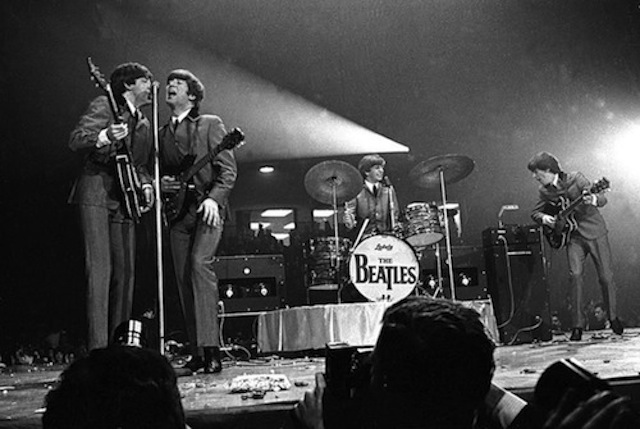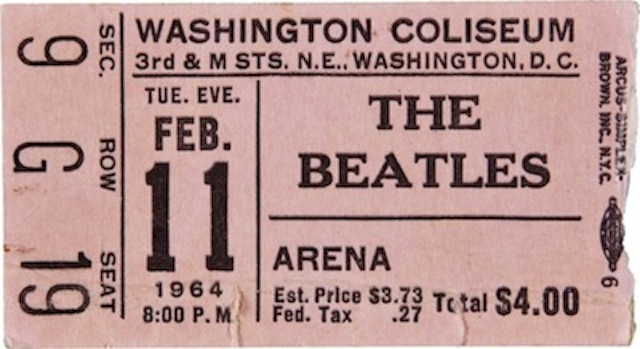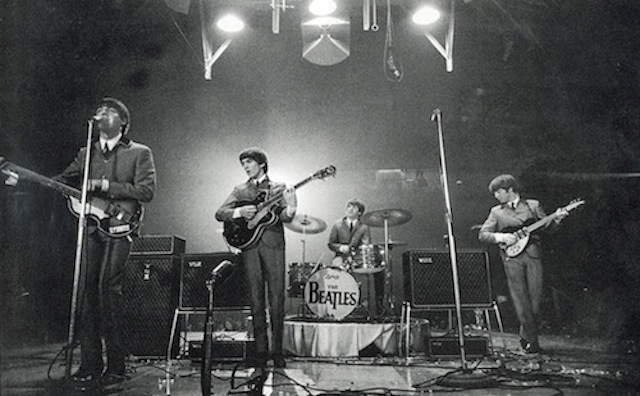The Beatles: The Lost Concert Limited Screening at Landmark's Century Centre Cinema
By Eric Hehr in Arts & Entertainment on May 5, 2012 3:15PM

The Beatles performing at The Washington Coliseum. February 11th, 1964.
On Feb. 11, 1964, two days after the group’s legendary appearance on The Ed Sullivan Show, The Beatles performed their first full-length concert in the United States at the Washington Coliseum in Washington D.C.
On a cold and snowy night, The Beatles took the stage in front of over 8,000 hysterical fans (it’s important to note that the Washington Coliseum had a maximum capacity of 7,000), tearing through a 12-song, hour-long set that included songs such as “I Saw Her Standing There,” “Twist and Shout,” and “She Loves You.”
Many Beatles aficionados regard the D.C performance as a landmark event not only in The Fab Four’s career, but also in the history of pop music. Although their invasion of America appeared to be an overnight conquest, The Beatles had actually spent close to seven years struggling to do anything outside of playing small clubs throughout the UK and Europe. Breaking into the American market had long been a dream of The Beatles; in their rose-tinted eyes America symbolized all-encompassing success, as well as the home of their heroes such as Little Richard, Chuck Berry, and Elvis Presley. But even as the band began to encounter celebrity status in the UK, they were still unable to crack into the American market.
The February 11th show at the Washington Coliseum was The Beatles' long-awaited pay-off: An accumulation of seven years of grueling schedules and hard work finally coming to fruition. Although The Beatles would give up touring only a few years later, the Washington, D.C., show captures The Beatles at the pinnacle of their live performances; a moment where ceasing live performances was the last thing on The Fab Four minds. Instead of being annoyed by the constant screaming from the frenzied crowd, as they would admittedly later become, The Beatles were overwhelmed by the crowd’s uncontrollable fervor. And while The Beatles performed that night on top of a makeshift boxing ring, it is clear from the performance footage that John, Paul, George, and Ringo were all actually standing on Cloud 9: bopping around stage in front of the over-capacity crowd they had always dreamed of playing in front of, officially paving the way for the coming British Invasion and solidifying Beatlemania in America.

A ticket-stub from the Washington Coliseum performance. Price of admission for a Beatles concert in 1964: $4.00.
Probably one of the most incredible parts about The Beatles' Washington Coliseum performance — as well as the majority of their early performances — is the fact that they have no stage monitors or tuners on stage with them. They’re playing in front of thousands and thousands of people who are screaming at the top of their lungs from start to finish, and they have no way to hear themselves or each other. Many modern musicians not only perform with various tuners (or live auto-tuning - Yuck!) and a plethora of stage monitors, but they also have in-ear monitors and numerous people running the stage sound. Not The Beatles. They took the stage, plugged straight into their Vox amplifiers, and rocked harder and played tighter than most modern bands with all the technological advancements and conveniences of modern live sound could ever dream of. The Beatles' live-show often get’s a bad wrap, but I challenge any band to play in front of 8,000-10,000 screaming fans without any way to monitor yourself and play as well as The Beatles.
Steve Cole’s documentary, The Beatles: The Lost Concert, examines the cultural impact of The Beatles' show at the Washington Coliseum, as well as explores the group's first trip to America through original interviews, historical footage, unpublished photos and rare artifacts. While the film is being publicized as “the lost concert,” the Washington Coliseum performance footage has in fact never been “lost.” If you’re an avid Beatles fan, you’ve most likely come across the greater majority of this footage through “The Beatles Anthology” or commonplace Beatles bootlegs. What Cole’s documentary does have to offer is exclusive interviews with music journalists and musicians, such as members of The Strokes, Steven Tyler, Chuck Berry, Mark Ronson, and fans who attended the 1964 concert, as well as a fully restored and remastered version of the historic event.

The Beatles performing at The Washington Coliseum. February 11th, 1964.
The Beatles: The Lost Concert has a limited two-day theatrical engagement across select cities in the U.S., and fortunately Chicago is one of those cities. On Thursday, May 17 at 7:30 p.m. and Tuesday, May 22 at 7:30 p.m.The Beatles: The Lost Concert will be screened at The Landmark’s Century Centre Theater at Clark and Diversey.
Chicagoland Beatles Fans: Here’s your chance to see one of the band’s best live performances in its entirety on the big screen, with fully remastered sound. Until they make this performance holographic (which may happen sooner than later), this is the best bet modern-day Beatles fans have of understanding what it felt like to see The Fab Four live. It’s doubtful that the “talking-heads” portion of the film will provide any new or innovative insight into The Beatles exceedingly well-documented history, but who knows — maybe Steven Tyler will rattle off a one-liner about what The Beatles meant to him as a youth and you’ll find yourself excusing yourself to run to the bathroom and cry. Maybe. Probably not. But you’ll never know if you don’t go.
Check out the official trailer for The Beatles: The Lost Concert below.
For more tickets and showtimes to "The Beatles: The Lost Concert" visit The Landmark Theater Official Website.